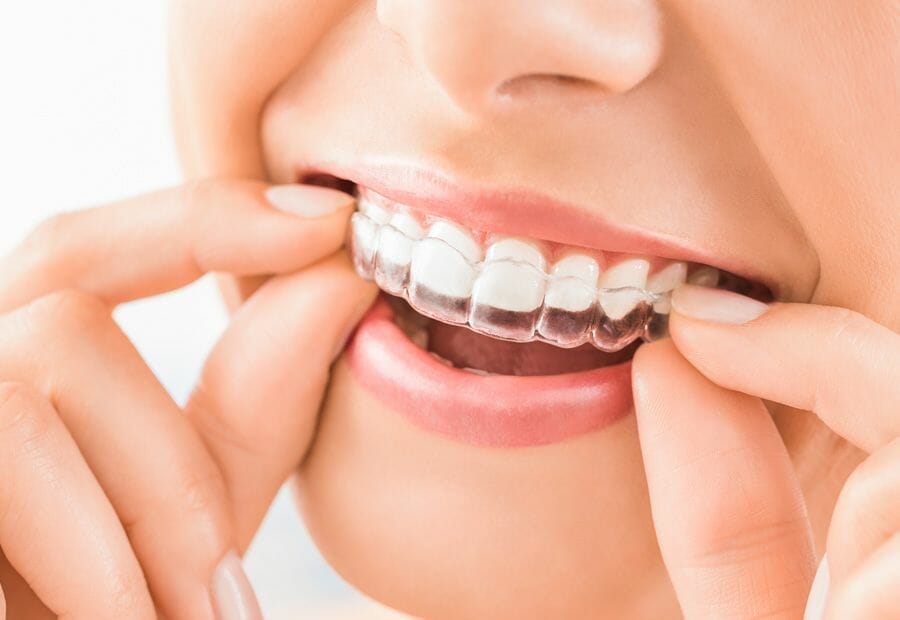At the mention of braces, many patients quiver.
They imagine constant tightenings, pain, and of course the dreaded brace-face label.
For some patients, braces are absolutely necessary, but not for all.
The alternative to braces are clear aligners, also known as invisible aligners.
Like braces, clear aligners straighten teeth although there are some key differences, of which we’ll detail later.
Clear aligners might be right for you.
But before you and your local Wellington orthodontist make that decision there are some important details about clear aligners that you should know about.
What Exactly Are Clear Aligners?
Clear aligners are near invisible teeth aligners made from polyurethane plastic.
Aligners are custom-made, removable, and designed to gradually straighten your teeth.
While they serve the same purpose they don’t require adjusting, have no wires or brackets to tighten, are removable, and are virtually invisible.
How Do They Work?
If they’re just a custom piece of plastic that is easily removable do they actually work?
Clear aligners are so effective that they are often used to treat the following:
- Crowded Teeth
- Overbite
- Underbite
- Diastema – small or large gaps between teeth
- Open Bites
But how exactly do they work?
Your journey to a healthy set of teeth begins with a consultation.
First, your orthodontist will examine and scan your teeth in order to plan your treatment then order custom-made aligners to straighten your teeth (we use either Invisalign or Spark aligners).
Once you have your aligners, it’s time to put them on and let them slowly adjust your teeth. They do this by slowly but surely moving teeth into their desired position.
Typically speaking you’ll use a new tray every 1-2 weeks. Being that teeth are stubborn, you’ll need to wear your aligners for around 22 hours every day to see noticeable effects.
Aligners should only be removed while eating and drinking and of course, to brush your teeth.
Taking Care Of Your Invisible Aligners
Aligners trays are changed every 1-2 weeks. Trays are plastic and as such easily degrade. Using a tray for more than the recommended time could protract how long it takes to adjust your teeth.
But just because you change them every week or two doesn’t mean you don’t have to take care of them.
It’s vital that you keep your aligners clean. To do so, brush your aligners with cold water and a soft toothbrush every time you brush your teeth. Brush both inside and out and be sure to reach every surface. After, simply wash your invisible aligners off with cool or lukewarm water. Never use hot water to clean your aligners! Cleaning regularly will kill bacteria and get rid of any unwanted smells.
Also, be sure to take them off when eating. Aligners can easily be warped if used while eating. Not to mention they’re blunt and will make the eating experience much more time-consuming. You also must take your aligners off when drinking anything but cold still water – no exceptions! Drinking hot liquids can distort the aligners, dark liquids (tea, coffee, etc) can stain your aligners and teeth, and because the aligners act like a paddling pool around the teeth, anything fizzy or sweet must strictly be avoided or the teeth can start to rot!
After eating, keep your aligners free of odour and food debris by both rinsing your mouth and your aligners. Quickly running them under cold water should do the trick, but a quick rinse shouldn’t take the place of a brush with toothpaste in the morning and at night.
When you do take your aligners to eat or drink, where are you going to put your aligners? Don’t leave them exposed to the elements. Rather, put them in your case while they’re not in use.
Lastly, keep your aligners out of extreme heat. Don’t leave them on the dash of your car while you hit the restaurant or place them in the sun while eating. Aligners are fragile and the smallest warping could make them significantly less effective or effect their fit.
How Long Do I Wear Invisible Aligners For?
Aligners are starting to sound like a lot of work, so by now, you’re probably wondering how long you have to wear them for.
On a daily basis ideally, you’d wear them for at least 22 hours (that means you sleep with them on).
How many months you have to wear them depends on how drastic the adjustment of your teeth is. Your Wellington orthodontist will be able to tell you after your appointment, but typically clear aligners are worn between 6-18 months depending on the severity of the problem(s) being treated.
Why Use Clear Aligners Instead of Braces?
There are plenty of advantages to using clear aligners.
- They’re very discrete and almost invisible
- Can be less painful than braces
- Don’t require monthly adjustments
- You can eat whatever you want
- Are usually used to treat milder problems so worn for a shorter time than braces
If there are so many benefits why would anyone wear braces?
Some teeth are more misaligned than others. So misaligned that they require the greater control braces offer. Let’s remember that braces are made of metal and attached to your teeth. They apply very directed pressure on one’s teeth and as such provide more significant results. Aligners are appropriate for teeth in need of less involved treatment.
Ultimately, that call comes down to your orthodontist and of course, your preference counts!
What Happens After You’re Done Wearing Braces?
After your clear aligners have been worn for a duration of time chosen by your orthodontist you should have beautiful, symmetrical teeth.
But here’s the thing.
It’s possible your teeth shift back into their original position.
To prevent this from happening you’ll need to wear retainers, just like with braces, regularly for 12 months after your clear aligner treatment has ended and then at least a few nights a week for life! Most people don’t realise that as long as we are living and breathing, are body is changing and our teeth want to move. Retainers must be worn for as long as you want the teeth to stay straight! The good news is retainers (usually) only need to be worn at night and it is easy to incorporate them into your night-time routine.
Next Steps
There are so many variables when it comes to clear aligners.
To know if they’re right for you book an appointment with us, your local, Wellington-based orthodontist.



